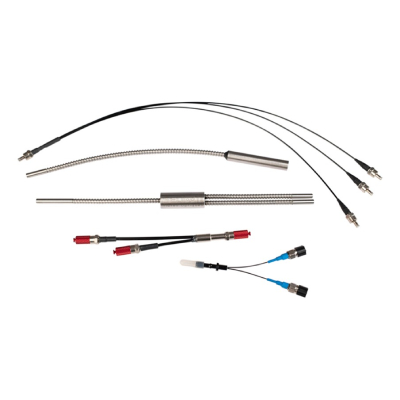SpectrographOptical
Fiber optic spectrograph
SEDI-ATI has delivered 64 slitlets of 16 optical fibers each, to form 2 identical slits of 512 fibers, aimed at transporting the light of celestial objects from the focal plate of the VLT to the two cryogenic spectrographs of the MOONS instrument.
MajorContraints
- Complex and coherent arrangement of large numbers of long optical fibers,
- Flexibility required to allow movement of the fibers in the jackets and small bend radius of curvature,
- Cryogenic environment at 130 Kelvin.
TheChallenge
The challenge for SEDI-ATI is to produce a telescope offset of a thousand optical fibers to link the telescope to the twin spectrographs of the MOONS instrument. On the telescope side, the fiber links will be placed in a rotating part (RFE), while on the spectrograph side the fibers will be in a cryogenic environment at 130 Kelvin.
What about MOONS ? The spectograph with a thousand optical fibers
MOONS is the new multi-object optical and near-infrared spectrograph mounted at the Nasmyth focus at the VLT. It has been designed primarily to study the formation of galaxies and their evolution throughout the history of the Universe, from the properties of millions of stars in the center of our own Milky Way, to millions of galaxies in the early Universe.
The MOONS instrument actually consists of two identical cryogenic spectrographs, cooled to 130 Kelvin in a single cryostat. Each spectrograph is fed with light by a fast and extremely accurate positioning system of about 500 optical fibers. MOONS will thus enable astronomers to obtain optical and near-infrared (640-1700 nm) spectra of about 1000 objects at the same time!
The infrared capabilities of MOONS
When a celestial object moves away from us, the so-called ‘redshift’ effect occurs: the light is shifted towards the red end of the spectrum. The infrared capabilities of MOONS will allow it to collect the spectral characteristics of millions of high redshift galaxies.
With these high-resolution spectra, astronomers will be able to measure the chemical abundances of certain elements in the atmosphere of stars, in relation to their dynamical properties. This will allow the reconstruction of the chronology of events that led groups of stars to reach the characteristics they exhibit today.
The study of our own galaxy offers a unique opportunity to study all the components of a galaxy, star by star. In this way, astronomers will be able to understand the details of the processes that take place during the formation of a spiral galaxy like the Milky Way.
In addition, the spectroscopy performed by MOONS will make it possible to measure the speed at which stars are moving away from or towards us. MOONS thus acts as a galactic GPS, allowing us to produce a 3D map of our Galaxy.
The MOONS fibre system with two curved slits
In partnership with the “Observatoire de Paris – GEPI”, SEDI-ATI has built two 200 mm curved slits, each of which contains 512 fibers of 150 µm core with Polyimide coating.
Each slit is placed at the entrance of one of the two MOONS spectrographs, in a cryogenic environment at 130 Kelvin.
A slit is composed of 32 slitlets arranged in a way to give the slit its curved shape. And each slitlet comprises a perfect alignment of 16 optical fibers.
The assembly is completed with inline multifiber hermetic feedthroughs, with one feedthrough per slitlet. The multifiber feedthroughs are mounted on a large flange to isolate the two spectrographs in the cryostat from the rest of the instrument.
Each bundle of 16 fibers is threaded into a long metal flexible tube on either side of the flange. It provides mechanical protection for the fibers, which will endure high mechanical stresses (rotation, displacement, short bending radius, etc.) in the mobile part of the instrument RFE (Rotating Front End).
At the focal plate of the telescope, the fiber bundles are split into individual fibers. Each fiber is connected at its end to a very short optical patchcord by a tiny connector and is positioned at the focus of the telescope via an FPU (Fiber Positioning Unit).
Not all the fibers in the slit are connected to FPUs: there are 1024 fibers in the two slits, for 1001 FPUs, which allows some flexibility matching FPUs to slitlets. Each fiber that is connected to an FPU can scan an object. Thus, 1001 celestial objects can be observed simultaneously!

From left to right: Mr FLORES (Director GEPI), Mr AMANS (Engineer GEPI), Mr LAPORTE (Deputy Directeur GEPI), Mrs GUINOUARD (Project Manager GEPI), Mr VINCHANT (CEO SEDI-ATI), and Mr LIOTARD (R&D Engineer SEDI-ATI).
Courtesy of: GEPI and SEDI-ATI.
The different stages
- May 2011: ESO selects the MOONS project to build a wide-field multi-object spectroscopic instrument.
- March 2017: final design review.
- March 2021: SEDI-ATI has finalized the delivery of the twin sets of fibers, for their upcoming integration by the ATC in Edinburgh.
- 2023: expected first light at the VLT.
SEDI-ATISolution
- Precise linear arrangement of 16 optical fibers of 150 µm core with Polyimide coating in a slitlet; 64 identical slitlets made,
- Mounting of 32 slitlets in a precise curved path to form a 512-fiber slit of 200 mm; 2 identical slits made,
- Creation of in-line hermetic feedthroughs; 1 per bundle of 16 fibers; 2 sets of 32 in-line hermetic feedthroughs, mounted on large, diameter flanges,
- Threading of 16-fiber bundles in metal tubes over long lengths.
AdvantagesSolution SEDI-ATI
- Expertise in the precise and orderly positioning of thousands of optical fibers in slits,
- Expertise in the threading of several hundred meters of optical fibers in metal protective tubes,
- Expertise in hermetic sealing technologies for fiber-optic systems,
- Expertise in optomechanics.
Related product
Fiber optic bundle assemblies for spectroscopy
Fiber-optic bundles are perfectly adapted to perform diffuse reflectance spectroscopic measurements.



